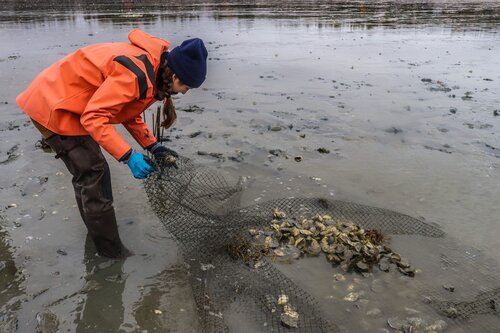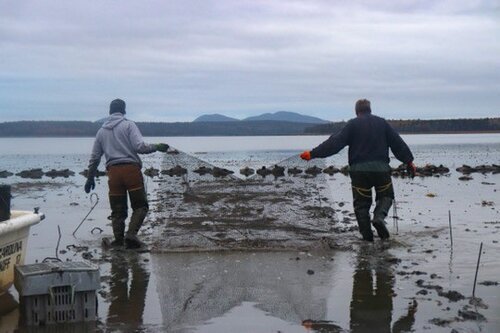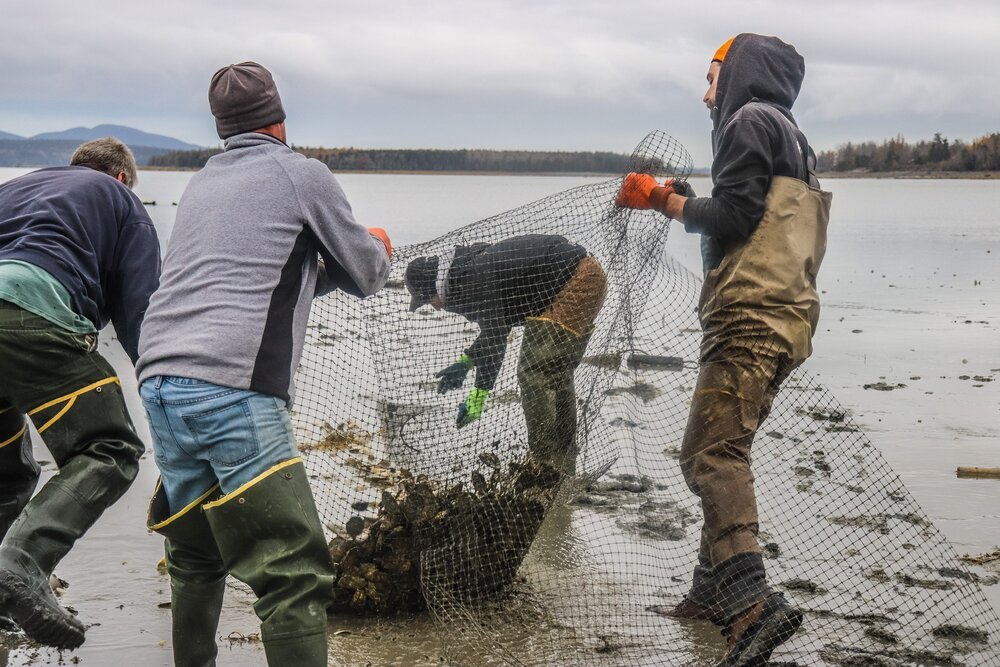Dictated by the Tides: An Evening with Mount Desert Island Oysters
We spent a chilly evening wading through the shallow waters of Goose Cove near Mount Desert Island with oyster farmer, Brian Harvey. What the tides revealed was truly an oyster lover's dream.
I remember the first time I read a tide table. It was years ago when I was hiking Schooner Head Overlook on Mount Desert Island. I was determined to find the fabled Anemone Cave, a cavern carved into the underbelly of the Overlook that housed a delicate marine ecosystem of anemones and barnacles. The cave was only accessible at low tide, and travel literature was replete with warnings that when the tide swelled into the cave, it did so quickly and with voracious force. Not being too familiar with tides, I sat on a rock outside what I believed was the Anemone Cave with my handwritten tide chart. As time wore on, and all I saw were rocks, I grew nervous that maybe I had followed all the wrong clues and was nowhere near the mythological cave. I stared out into the ocean, ready to admit defeat. Suddenly, I noticed the waters had begun to retreat from the cliff side. Slowly, the chasm I had dreamed of finding revealed itself. It was the first time that I recall watching in wonder as the tides unveiled something I arduously had searched to find.
An Invitation
Two weeks ago, I received an email from John Herrigel, the mastermind behind Maine Oyster Company. John was taking a team to Mount Desert Island Oysters to help oyster grower Brian Harvey harvest the last of the season’s bivalves, and prepare his lease site for winter. He kindly extended the invitation. I love meeting oyster growers, and jump at any opportunity to grab my camera and go on a journey to a new farm.
John warned me at the outset, however, that this wouldn’t be like a typical oyster farm tour. He asked if I had a pair of hip waders, and how I felt about mud. This only sparked my curiosity more. It’s one thing to write about oyster growing while watching other people do it. And then there’s getting in the literal mud up to your knees on a frigid October night, and hauling hundreds of pounds of oysters back to shore with you. I replied to John’s email with three words: “let’s do it.”
The beauty of oyster growing is that everyone has a unique reason behind the technique they use for oyster farming, the geographical location of their lease site, and why they pursued oyster farming in the first place. Most oyster farmers congregate their leases on bodies of water in Southern and Midcoast Maine. The Damariscotta is already center-stage in the oyster world as being one of the finest producers of bivalves, and the New Meadows River is quickly earning its accolades. As you travel further north, cities turn to towns, the coastline of Maine becomes more unruly, and the oyster farms are few and far between.
Mount Desert Island is a 108 square mile island off the coast of Maine. The island is a geological wonder, boasting sea-floor mud deposits stemming from volcanic ash deposited over 540 million years ago. The island has soaring cliff sides, the result of collisions of several microcontinents over 484 million years ago. And, as I discovered years ago on my excursion to Schooner Head, the area is replete with hidden coves and fast-changing tides.
***
The journey up to Mount Desert Island is an adventure on seemingly a single road that winds its way through a number of sleepy New England towns. Not only were the views gorgeous, but I was thankful that my companions – Alicia, Kevin, and John of Maine Oyster Company – were all passionate aquaculture experts, who enthusiastically shared stories of working on various oyster farms. They were also kind enough to give some tips for not getting stuck in the mud.
***
We met Brian Harvey at a boat launch at the Mount Desert Narrows around 3:30 p.m. Brian is a gentle giant whose enthusiastic appreciation of aquaculture is readily apparent to anyone who meets him. Brian has owned Mount Desert Island Oysters for over ten years. Before that, he spent time harvesting oysters on the Bagaduce River in Downeast Maine. Brian greeted John with an enthusiastic handshake, and then immediately checked in with the rest of us to see who needed hip waders and head lamps because, we were “definitely going to need them.”
Brian gently coaxed us along as we slipped on warmer clothing and our hip waders. He needed to ensure that we departed from the boat launch and traveled across the Mount Desert Narrows to his lease site at Goose Cove while the tide was still high. If we didn’t make it to Goose Cove before the tide started to slip out, we would have a long trudge through the mud flats to the oysters. Brian reassured us we did not want to make that journey.
Hip waders hiked high, and headlamps in hand, we helped one another onto Brian’s skiff. Our entrance to the sea was marked by large boulders splattered with colonies of white barnacles and adorned with swarms of mustard yellow seaweed. Resting against the boulders were mesh bags holding already-harvested oysters who were waiting to be sunk to the bottom of the sea for their winter’s rest.
Brian’s 5 acre lease site for his prized Mount Desert Island Oysters is a short boat ride across the Mount Desert Narrows to Blue Hill Bay and Goose Cove. Along the way, the landscape flaunted its gorgeous fall colors – bright reds and oranges dotted the tree line, as a light layer of mist began to swell at the top of the distant hills.
I remarked that we must have been getting close to the lease site when I saw the first line of oyster cages floating in the distance. Brian chuckled to himself and murmured “we aren’t there yet.” Brian quelled the engine just beyond the floating cages, when we were about one-hundred feet from the shoreline, in the heart of Goose Cove.
“Now we wait,” Brian explained.
The magic of the Mount Desert Island Oysters lease site is what lies underneath the waters, and can only be accessed at extremely low tide, which occurs on only a handful of days per month. Brian explained he has between two and four days a month to go out to his lease site at low tide, and harvest oysters to sell. On the other days of the month, the oysters are carefully tucked away underneath the waves. Brian’s entire oyster business is dictated by the ebb and flow of the tides – which has a sort of mythology to it.
While we waited for the tides to recede from the cove, Brian dipped his hands into the cold water and began pulling out oysters to shuck. Brian was eager to show off his “side-shuck” technique, and recounted how he has been teaching his handiwork to raw bar workers throughout Mount Desert Island.. Mount Desert Island Oysters are gorgeous, rounded green-shelled beauties that begin with a first wave of smoky brine, and follow with a sweet, clean finish. As we sat slurping oysters fresh from the sea, the cold ocean waters began to pull themselves away from the shoreline, and ran underneath our boat, leaving us in the mud.
As promised, the waters revealed what they were hiding. There were rows upon rows of netting lined up on the mud flats. Situated on top of those nets were thousands of full-grown oysters. Brian Harvey practices an oyster growing technique called bottom-planting. When Brian purchases baby oysters, he initially places them in bags that float on the water’s surface for their first summer. Like all oysters, the baby oysters are sunk to the bottom of the lease site when the water temperatures dip below 50 degrees for overwintering. When the water temperatures warm in the spring, Brian does not return his one-year old oysters to the surface to float in bags or cages. Rather, he disperses all of his oysters in neat rows on top of netting that is anchored in the mud with sticks. The oysters grow there, on the bottom of the seafloor, until the waters cool, and it is time to move them to deeper water for the winter.
That’s where we came in.
Before getting out of the boat, Brian gave us one warning—“if you feel yourself about to fall in the mud, you need to yell out.”
“So people know where you are in case it is dark?” I asked.
“No,” Brian said, as he grabbed a pair of oyster gloves and proceeded to climb off the boat, “so we can laugh at you.”
Between 4:30 pm and 8:00 pm, our mission was to completely empty the lease site of oysters. Which doesn’t sound like too taxing of a task until you add in the mud-up-to-your-calves component. The harvesting process begins by taking the end of the 20 foot netting and gradually rolling it, and all the oysters forward, to the other edge of the netting. As you roll the netting, the oysters resting on the netting begin to tumble forward, and eventually amass into a massive oyster pile that is then stuffed into a plastic storage container. We worked in teams of two, laughing (and, occasionally falling face-first in the mud) as we heave-hoed over thirty net’s worth of oysters into containers. Some containers were placed back on the boat to be taken back to shore. There, they would be sorted according to size. The oysters measuring over 3 inches in size would be sold to nearby restaurants; the babies would be placed in cages, and sunk to the bottom of the sea near the boat ramp for a winter’s sleep until next season.
As we trudged in the mud in our waders, the sun slowly began to dip between the cliffs that soared in the distance, and a light fog crept its way into the cove where we were working. We worked for another hour in the darkness with only a faint beam of light radiating from our headlamps. The only sound that filled the air was the scraping of hundred-pound oyster crates being carried through the mud. As the moon began its ascent into the sky, the mud began to dampen, our footprints began to fill with pooling water, and the sound of the waves began to echo closer. Brian instructed us back to the boat, indicating, rather cinematically, that it was “time.”





